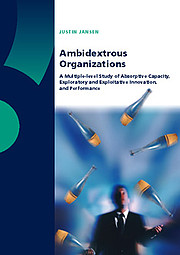Ambidextrous Organizations: A Multiple-Level Study of Absorptive Capacity, Exploratory and Exploitative Innovation and Performance Defended on Friday, 29 April 2005
Balancing and synchronizing exploration and exploitation is fundamental to the competitive success of firms in dynamic environments. Despite the importance of reconciling exploration and exploitation within organizations, however, relatively little empirical research has examined this challenge facing numerous organizations. This study develops a multi-level framework and explores how ambidextrous organizations can successfully cope with both types of innovations across organizational units. It not only examines performance implications of organizational ambidexterity, but also investigates how organizational units develop exploratory and exploitative innovations. Results indicate that the most effective ambidextrous organizations balance exploratory and exploitative innovation by separating both types of activities in different organizational units. Moreover, findings demonstrate that organizational units require different types of combinative capabilities to influence their absorptive capacity, and subsequently, their exploratory and exploitative innovations.
Keywords
Organizational Ambidexterity, Financial Performance, Paradox, Exploration and Exploitation, Absorptive Capacity, Combinative Capabilities, Competitive Advantage, Organizational Knowledge, Innovation













